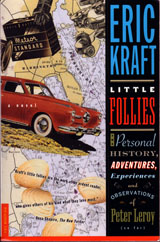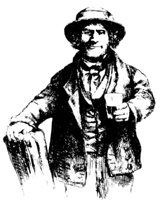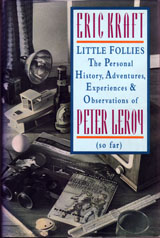| |

YOU CAN READ THE FIRST HALF
OF THE BOOK HERE,
ONLINE, ONSCREEN.
YOU CAN ORDER THE
PICADOR USA EDITION
AT
AMAZON.COM
OR
BARNES&NOBLE.COM
|
|
 ATER,
AS A YOUNG MAN, I went to work as an editor on the staff of The Young
People’s Cyclopedia. This compendium of useful facts, historical
anecdotes, brief lives, practical instruction, oversimplifications, and
misinformation was compiled first in a small office above Jack’s Twenty-Four
Hour Jokes, on the corner of Bolotomy and Main, in the heart of Babbington,
and later, when it had become an institution, in a concrete castle, one
of those structures that businesses build to show their nostalgia for feudalism,
outside town in a spot that had once been a potato farm and now held many
industrial and office buildings and was called, preposterously, a park.
The entries were written by a network of experts, amateurs, teachers, and
housewives who were assigned topics to develop within strict limits of
space. To add a little to the salary I received there, I wrote some
entries myself, borrowing as a pseudonym the name of a good friend, Eliza
Foote. As Eliza Foote, I wrote many entries in The Young People’s
Cyclopedia, including entries for most of the Leroys, points of interest
in and around Babbington, bivalves, and friends and acquaintances who deserved,
it seemed to me, a little space on a library shelf. For the entry
on Black Jacques, I used some of what Great-grandmother had told me, and
lots of sawdust. ATER,
AS A YOUNG MAN, I went to work as an editor on the staff of The Young
People’s Cyclopedia. This compendium of useful facts, historical
anecdotes, brief lives, practical instruction, oversimplifications, and
misinformation was compiled first in a small office above Jack’s Twenty-Four
Hour Jokes, on the corner of Bolotomy and Main, in the heart of Babbington,
and later, when it had become an institution, in a concrete castle, one
of those structures that businesses build to show their nostalgia for feudalism,
outside town in a spot that had once been a potato farm and now held many
industrial and office buildings and was called, preposterously, a park.
The entries were written by a network of experts, amateurs, teachers, and
housewives who were assigned topics to develop within strict limits of
space. To add a little to the salary I received there, I wrote some
entries myself, borrowing as a pseudonym the name of a good friend, Eliza
Foote. As Eliza Foote, I wrote many entries in The Young People’s
Cyclopedia, including entries for most of the Leroys, points of interest
in and around Babbington, bivalves, and friends and acquaintances who deserved,
it seemed to me, a little space on a library shelf. For the entry
on Black Jacques, I used some of what Great-grandmother had told me, and
lots of sawdust.
LEROY, JOHN PETER “Black Jacques,” 1836[?]-1906, American brewer,
born Algiers. Among beer drinkers, it is sometimes said of Black
Jacques that “He invented beer.” Although this is not correct, it
is arguably true that he developed the best of beers; this was the legendary
Leroy Lager, a sturdy and honest drink, relative only by name to the insipid
brew later marketed by his son, John Henry (“Fat Hank”). Often credited
(erroneously) with having first marketed beer in pint bottles, Black Jacques
did introduce the now widespread practice of printing a poem on a label
on the back of each bottle, thus raising the tone of taverns across the
land.  The
period when Black Jacques himself ran the Leroy brewery has come to be
known as the Golden Age of Brewing. Sales of the original Leroy Lager
were never large, and Black Jacques grew increasingly bitter about its
lack of success. Like many another original, he labored under the
delusion that something of essentially limited appeal could, as the result
of a mutation of public taste, acquire a large and devoted following.
In 1894, broken in spirit, he gave the Leroy brewery to his son as a wedding
present. Fat Hank, more in tune with popular taste than his father,
began brewing a beer that went down more easily than the original, and
he launched a promotional campaign that set an industry standard.
He continued to publish poems on the Leroy labels, but required that each
poem submitted be accompanied by six caps from Leroy bottles, the only
requirement for acceptance. At least partly as a result of this practice,
the number of poets began a steady increase that has not yet peaked.
Another more or less direct consequence was the introduction of the six-pack
(q.v.), which put six caps into the hands of the bibulous scribbler at
once, in an easy-to-handle package. Fat Hank grew increasingly concerned
that his success could not last. He calculated that if sales continued
to grow at their then-current rate, by the end of the twentieth century
every person in the world capable of holding a pen in one hand and a beer
bottle in the other would be spending every evening drinking Leroy Lager
and writing poems; foolishly, Fat Hank assumed that this was an impossibility.
He sold the brewery, in a move that seemed like mad impetuosity from the
outside but that Fat Hank, in his autobiography Nobody’s Fool, described
as the shrewdest decision he had ever made, admitting, however, that his
next move fell considerably short of it on the shrewdness scale.
He put all the proceeds into a series of service-stations-cum-clam-bars.
He claimed to have had a vision one restless night of an endless line of
motorcars inching along a paved road, each car filled with a happy family,
eating clams on the half shell. “Only a fool,” he is said to have
said, “could fail to see that cars and clams are the coming things.”
The story of the failure of this venture is a familiar one. Millions
are acquainted with the romanticized version that is the basis of the musical
film The Flop, and every business school student knows it like the
back of his hand, thanks to the lengthy chapter devoted to it in Cartel’s
basic text, The Big Book of Business Blunders. Essentially,
blame can be ascribed to three causes: (1) the difficulty of assembling
a staff adept at both automobile mechanics and cooking, (2) the incompatible
odors produced by automobile maintenance and clam cookery, and (3) Fat
Hank himself, who, those in the know aver, began to lose faith in his vision
as soon as he had embraced it. —EF The
period when Black Jacques himself ran the Leroy brewery has come to be
known as the Golden Age of Brewing. Sales of the original Leroy Lager
were never large, and Black Jacques grew increasingly bitter about its
lack of success. Like many another original, he labored under the
delusion that something of essentially limited appeal could, as the result
of a mutation of public taste, acquire a large and devoted following.
In 1894, broken in spirit, he gave the Leroy brewery to his son as a wedding
present. Fat Hank, more in tune with popular taste than his father,
began brewing a beer that went down more easily than the original, and
he launched a promotional campaign that set an industry standard.
He continued to publish poems on the Leroy labels, but required that each
poem submitted be accompanied by six caps from Leroy bottles, the only
requirement for acceptance. At least partly as a result of this practice,
the number of poets began a steady increase that has not yet peaked.
Another more or less direct consequence was the introduction of the six-pack
(q.v.), which put six caps into the hands of the bibulous scribbler at
once, in an easy-to-handle package. Fat Hank grew increasingly concerned
that his success could not last. He calculated that if sales continued
to grow at their then-current rate, by the end of the twentieth century
every person in the world capable of holding a pen in one hand and a beer
bottle in the other would be spending every evening drinking Leroy Lager
and writing poems; foolishly, Fat Hank assumed that this was an impossibility.
He sold the brewery, in a move that seemed like mad impetuosity from the
outside but that Fat Hank, in his autobiography Nobody’s Fool, described
as the shrewdest decision he had ever made, admitting, however, that his
next move fell considerably short of it on the shrewdness scale.
He put all the proceeds into a series of service-stations-cum-clam-bars.
He claimed to have had a vision one restless night of an endless line of
motorcars inching along a paved road, each car filled with a happy family,
eating clams on the half shell. “Only a fool,” he is said to have
said, “could fail to see that cars and clams are the coming things.”
The story of the failure of this venture is a familiar one. Millions
are acquainted with the romanticized version that is the basis of the musical
film The Flop, and every business school student knows it like the
back of his hand, thanks to the lengthy chapter devoted to it in Cartel’s
basic text, The Big Book of Business Blunders. Essentially,
blame can be ascribed to three causes: (1) the difficulty of assembling
a staff adept at both automobile mechanics and cooking, (2) the incompatible
odors produced by automobile maintenance and clam cookery, and (3) Fat
Hank himself, who, those in the know aver, began to lose faith in his vision
as soon as he had embraced it. —EF |
|
|
 |
|




